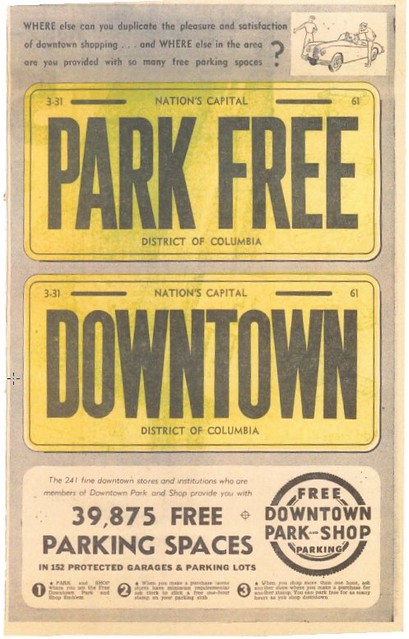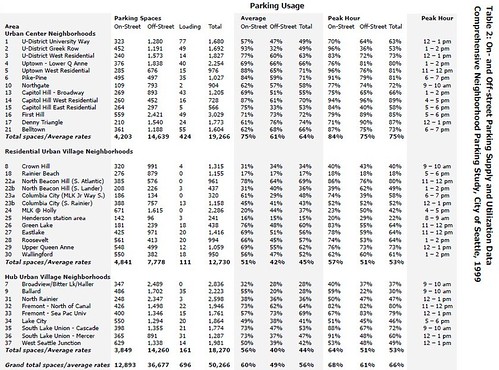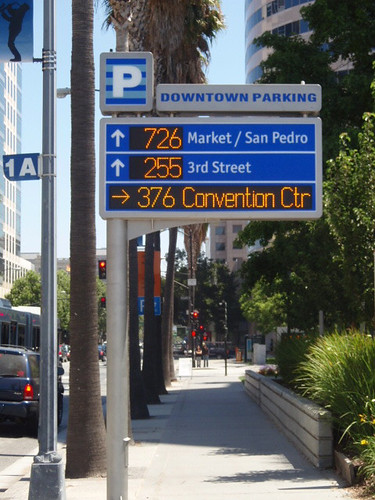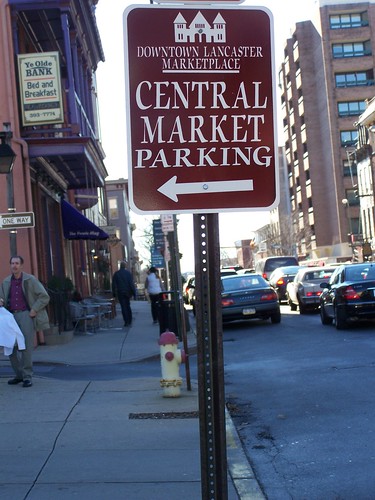Testimony on parking policy in DC
There is a hearing today at City Council on the "residential parking permit program." It's a related but separate process from DC Department of Transportation's "Parking Think Tank" initiative, the last meeting of which was written up in GGW, "At summit, people ask for free parking for themselves."
This testimony summarizes for the most part, my thinking on the issue.
Thank you Chairman Cheh and Council members for the privilege of testifying to you today about the Residential Parking Permit program. I am Richard Layman of the Citizens Planning Coalition.
Even in the best situations, on-street and off-street parking is problematic. Parking is a problem in commercial districts, in night time entertainment districts like Adams-Morgan, Georgetown and H Street; around subway stations; and in densely populated neighborhoods (typically R4), especially in the core of the city.
Most commercial districts either include housing or abut neighborhoods making “residential” parking problems a citywide issue. We suggest that you consider that your review of the “Residential Parking Permit” program is too narrowly conceived, that a more comprehensive review is necessary.
While sustainable transportation advocates like me are quick to suggest that the problem is too many cars, others make different arguments: not enough parking spaces; lack of municipal parking structures; escalating prices; hyper-aggressive enforcement; nonresidents and institutional users competing for spaces. In any case, more people want to park than there are parking spaces available.
It’s obvious why parking is often called the third rail of local politics because some people won’t be able to get what they want—it’s impossible to provide an unlimited supply of free parking in a tightly packed place.
Concurrently with your Committee’s review of the RPP program, the DC Department of Transportation is conducting a parking planning initiative. However, I would argue that their process needs to be more comprehensive and certainly doesn’t rise to the detail present in the Parking and Curb Space Management Element of Arlington County’s Master Transportation Plan (both are national best practice examples). (FOOTNOTE 1 and 2)
This hearing provides the opportunity for Council to step in and point the Executive Branch in the direction of a more comprehensive parking and curb space management planning effort.
The planning process has an added benefit of educating users on the variety of needs, constraints, opportunities, and problems present within the system by different stakeholder groups.
For example, people complaining about the use of street space for bike lanes and transitways fail to consider that every person using alternative means to get from place to place is one less person competing with them for scarce parking places. Similarly, a bike corral uses one street parking space, but provides parking for ten customers. By including off-street parking spaces as part of the parking system, when street space usage is directed away from parking, negative impacts on parking availability can be minimized, etc.
Without a comprehensive plan, the Executive and Legislative Branches of DC Government lack the necessary knowledge and framework required to shape a coordinated, integrated, and complete response to the “parking problem,” one that addresses, to the best and fairest extent possible, the concerns of all stakeholders.
And while the Legislative Branch may prefer to address parking issues without the constraints of plan guidance, the reality is that comprehensive functional plans help us to better address complex and controversial matters, while providing “cover” and support to elected officials, who, let’s face it, don’t like to make difficult decisions.
The problems with parking policy and practice. The RPP program is both part of the problem and part of the solution. This list below summarizes most (FOOTNOTE 3) but not all of the issues that a comprehensive parking planning effort (FOOTNOTE 4) should address:
• L’Enfant’s design of the city optimizes walking, biking, and transit (FOOTNOTE 5);
• There are competing priorities for the use of street space (short term and/or long term parking, through traffic lanes, bike lanes, dedicated transitways, community public space, residents vs. nonresidents);
• There is a limited inventory of on-street parking spaces;
• Car users typically expect an abundant supply of low price/no price on-street parking wherever they go: in neighborhoods; commercial districts; Downtown; and other destinations;
• Dense neighborhoods have more dwelling units and residents of driving age than can be supported by existing on-street parking spaces;
• Many neighborhoods are experiencing increases in population and commercial activity—in some places commercial activity also extends later into the evening; all contribute to increased parking demand;
• DC competes with activity centers in other jurisdictions that may provide no cost, low cost, and/or more convenient parking;
• 2 hour time limits should probably be extended to 3 hours to encourage trip chaining (hair appointment + meal + shopping requires more than 2 hours; finding a place to park + walking to your destination + meal + shopping probably requires more than 2 hours; etc.)
• Many visitors to the city are uncomfortable having to parallel park;
• City policy prioritizes parking meter revenue generation at the expense of achieving other goals;
• On-street parking spaces are underpriced compared to off-street rates, shifting demand to street spaces;
• Rising transit fares and a decrease in federal transit benefits has shifted some people to driving, adding to parking demand;
• City policy currently privileges car owning residents at the expense of other users;
• Residential parking permits are almost free (the cost for a permit works out to less than ten cents/day);
• City Council intervention on residential parking matters generally avoids consideration of RPP price increases as one method to shape demand in the context of limited supply;
• Performance parking “pilot” projects are designed to prioritize resident parking;
• The free visitor parking permit program offers potential for abuse and fraud;
• New multiunit housing adds parking supply but also increases demand;
• New zoning policies eliminating requirements for off-street parking in transit priority zones are controversial because this may increase demand for existing on-street parking spaces (FOOTNOTE 6) without adding new capacity;
• Integrating transportation demand management programming (car sharing, biking, better transit, walking, package delivery, coordinated freight delivery management, etc.) into the RPP program would help reduce parking demand;
• Car sharing as a revenue source is prioritized over its role as an element of managing parking demand (non-car owning residents who use car sharing pay far more for the use of public space parking than do car owners);
• The RPP program privileges residents in the immediate vicinity over residents from other parts of the city;
• The RPP program pits various stakeholder groups against each other, in competition for scarce space, and makes the process very acrimonious;
• RPP zones should be smaller to reduce abuse (it’s done in some neighborhoods, e.g., in Ward 4, RPP zones are tied to ANC boundaries, and not in others, in any case, practice is inconsistent);
• The RPP program provides limited options—free unlimited parking for immediate residents, a 2 hour limit for everyone else, and aggressive parking enforcement;
• Under-pricing of on-street parking makes provision of off-street parking economically infeasible;
• Commercial parking operations mostly focus on tenant/employee needs, to the exclusion of serving other market segments;
• Post 9/11 security concerns mean that for the most part, parking facilities in federal buildings cannot be used by the public;
• City parking policies do not treat off-street (commercial) and on-street parking as two linked components in one integrated system;
• Parking wayfinding and information systems are inadequate or nonexistent;
• (Most people don’t know that) Lobbying of Congress by the local parking industry (FOOTNOTE 7)has prevented DC from developing a system of municipal parking structures (unlike other nearby communities such as Montgomery County, Arlington County, the City of Alexandria, and the City of College Park—10% of the College Park city budget is generated by revenue from parking);
• The contractor parking permit program offers a model to serve other market segments/ stakeholder groups that are ignored by current practices (employees of commercial businesses located in RPP zones; Eastern Market flea market vendors needing to park on weekends; and teacher, police officer, and firefighter parking in the vicinity of their duty stations; etc.);
• Disabled parking accommodation and abuse of the privilege needs to be addressed.
Each aspect should be addressed as part of a comprehensive plan and each item reinforces the point that the Committee should broaden the scope of its review of parking matters beyond the more narrow definition of the RPP program.
In doing so, the Committee should use its review to shape the values, goals, objectives, and priorities of DDOT’s parking planning and management programs:
1. Ensuring that the process is fair and better serves all users, not just car owning residents;
2. Recognizing that as long as City Council is unwilling to support pricing changes to the RPP program, there will continue to be far more demand for parking than there is parking available.
3. Ensuring that if DDOT is yielding their authority to enact expanded zone parking restrictions to ANCs by providing only limited review, then the City/DDOT needs to ensure that ANCs enact such restrictions with full due process.
With regard to the RPP program, the city has a wider range of options, if we are willing to consider best practices elsewhere and can accept the relevance of market economics.
Options include:
• Charging more for permits: Toronto (from $216 to $576/year + sales taxes); San Francisco ($102/year); and Vancouver (up to $76/year) charge more than DC for residential parking permits;
• Some cities (Savannah; Seattle) raise the permit price for additional vehicles registered at the same address;
• Toronto’s highest street parking permit price is assessed to permit holders who have on-site parking available to them;
• No city appears to increase pricing for additional permits comparable to how bike sharing systems escalate charges for use beyond 30 minutes—the rate increases with each additional 30 minute increment that the bike is checked out (in DC, the price is $2 for the first additional 30 minute period, $6 for the second 30 minute period, $14 for the third 30 minute period, etc.) ;
• Vancouver has three different RPP rates ($38, $56, $76), set according to the parking demand and supply issues present in particular neighborhoods;
• No city charges for permits based on vehicle size (e.g. larger vehicles pay more, truly smaller vehicles—super subcompacts—pay less);
• Seattle provides a price discount for low-income households;
• San Francisco allows businesses located in RPP zones to purchase up to four parking permits, including three permits for use by delivery vehicles;
• Chicago charges $8 for a pack of 15 visitor passes;
• Assessing personal property taxes on motor vehicles is another way shape demand and generate revenues to support the provision of transportation infrastructure (Fairfax, Alexandria, Falls Church, and Arlington do this). Note that the tax is assessed on all vehicles, not just those parked in public space;
• One size fits all policies aren’t helpful. For example, denser neighborhoods should have higher priced permits, recognizing that supply, demand and opportunity costs are higher than in less dense neighborhoods, locations abutting subway stations, etc.
Conclusion and Recommendations
The city needs a complete, thorough, and innovative Parking and Curb Space Management Plan serving all users in the fairest way possible.
City Council can lead the way forward through this hearing and oversight process, by (1) directing the DC Department of Transportation to create a robust and comprehensive Parking and Curb Space Management Plan, (2) adopting the finished plan, and (3) ensuring that the plan is implemented.
Thank you.
Footnotes
1. Arlington County Parking and Curb Space Management Element
2. Arlington County Master Transportation Plan. Parking elements in transportation plans from San Francisco, Vancouver, Sacramento, and Seattle are also best practice models.
3. Parking matters not relevant to the scope of this hearing are management of freight deliveries, special event mobility management, tourist bus parking, and commercial district loading zone operation and pricing.
4. Ideally, a comprehensive planning effort would include a discussion of the history of parking in the city, financing systems, how the programs work now, system coordination options, tax and funding options, and case studies of best practice concerning finance, revenue, technology, innovation, system coordination, management, and communications.
5. Adams, J.S. “Residential structure of Midwestern cities.” Annals of the Association of American Geographers, 60: 1, pp. 37-62 (1970). Melosi, M.V. “The Automobile Shapes the City: From ‘Walking Cities’ to ‘Automobile Cities.’ Muller, P.O. “Transportation and urban form: Stages in the spatial evolution of the American metropolis,” in Susan Hanson and Genevieve Giuliano, eds.,The Geography of Urban Transportation (New York: Guilford Press, 3rd rev. ed., 2004), pp. 59-85.
6. DeBonis, Michael. “D.C. zoning revamp stokes residents’ fears about changing city.” Washington Post, 12/1/2012.
7. Bernstein, Adam. “L.B. Doggett, Jr.; Parking Tycoon, Civic Leader.” Washington Post, 8/14/2008.
From the 1950s to the early 1970s, Downtown DC businesses sponsored a comprehensive parking validation program for their customers. Advertisement (scan), Washington Post, 1/22/1961, p. A11.

Neighborhood parking survey data from the Seattle Transportation Strategic Plan

Integrated real time parking wayfinding signage, San Jose, California

Downtown Lancaster Central Market parking sign

Labels: car culture and automobility, car sharing, neighborhood planning, parking and curbside management, public space management, transit oriented development, transportation planning



8 Comments:
Well, at least you didn't reference Arlington. Oh wait!
Look, a couple style points first, then what you are missing, and finally what is wrong.
A. Style points
1. Narrative.
I don't know if you are testifying in person, the written is always different then.
However, I think you need a narrative, and the best one you've got is Footnote 7 and the need for more public parking.
2. Root caues never win arguments
Seond, you're aruging root causes, and basically telling them to f*ck off, which isn't very helpful. Basically your takeawy is point 3 (ANC due process) which you don't really build up (see narrative)
3. Laundy lists never get done.
Then it just a laundry list. Why? Well, I skip to the end and see what you want. And I can't find it, and the entire thing falls down.
B. What you are missing
Basically disabled, fines and then revenue
Nothing about the disabled parking grab and why this is bad. Maybe it is the laundry list
DC makes a lot of money off fines, an I'd wager a few RPP areas generate a lot of revenue. Most do not. I still remember parking on Macomb for the summer and getting away except for last 3 days, when I got hit with 15 tickets. Meter maid usually didn't make it up that far, or someone complained.
And ultiimatley parking is treated as a revenue source in this city and you've got to find a way to broaded that stream and make it more equitable -- rather than fines or fees.
C. What is wrong
I'd agree with you the basic point that using RPP as a subsidy to residents is the problem (and in that case Arlington is the worst and prime offender). But is pricing and the market the solution -- not really. A market can give you price discovery, which is useful. But the price is only one way to allocate spaces, and is very flawed.
REally the future is wayfinding, and you've got to impose a tax on cars to pay for that upgrade.
Well this was a grab bag, because I didn't have time to write a full analysis, which would have many more pages and a lot more time.
I sure don't want to write free plan for them.
HOWEVER, testimonies should be used to shape the discussion.
The point of the grab bag is that there are a lot of issues that need to be addressed, that won't be with a narrow definition of the "problem" being RPP. And I would argue that they are organized in a logical fashion.
(And have you ever read the ArCo transpo elements? They are quite good...)
But... when I say testimonies are to shape the discussion they are really opportunities.
The written testimony is the detail, but it took me a couple years to realize you don't read it.
You use your time to make the major points. For me, when I testified I spoke extemporaneously (although that guarantees you miss some stuff) and made five points:
1. The system is focused on privileging car owners over everyone else.
2. You can't ignore market economics and the parking "problem" in DC is a perfect example of the failure to apply the most basic market principles.
(Using price to allocate parking might be flawed, but it works a lot better than all the other alternatives. I might not have done well in econ in college--a problem with graphical reasoning--but it's pretty obvious what the problems are now.)
3. The issue of political fallout that CM Wells discussed around the disabled parking issue is also relevant to the cycletrack on L St. discussion plus closing 7th St. SE on weekends for Eastern Market.
4. THE POINT BEING THAT WE NEED A COMPREHENSIVE, THOROUGH, AND INNOVATIVE PARKING AND CURBSIDE MANAGEMENT PLAN, AND THAT COUNCIL SHOULD MOVE THAT TO THE TOP OF THE AGENDA. Plus a plan gives cover for making hard decisions.
5. People including Emily Mechner and CM Wells made the point about using increases in revenue from parking to fund transportation improvements. I can't believe I didn't link the two, it's basic Shoup. (Wells also mentioned the idea of linking some of the parking funds generated by particular neighborhoods to neighborhood improvements, although there are some equity issues as the neighborhoods without this kind of demand won't generate monies and will be left behind in terms of neighborhood improvements. In his discussion, he is now calling this "participatory budgeting," having expressed stinging when I said he shouldn't have dropped a neighborhood constituent fund but shifted allocations to participatory budgeting methods.)
It could be used to create my model "intra-neighborhood" transit system.
DC Tertiary Transit Network: intra-neighborhood bus services. Maybe private shuttle services (i.e., Washington Hospital Center to/from Brookland Metro, university shuttle services, etc.).
http://urbanplacesandspaces.blogspot.com/2009/04/earth-day-and-intra-neighborhood.html
I will try to write an expanded entry on this.
At least these things are being talked about.
whoops, point 5 was creating a "parking best practice toolbox" a kind of set of case studies of best practices in funding, operations, technology, etc. I can think of at least 30.
This comment has been removed by a blog administrator.
Having never testified at the DC council, I can't say if the ever read the written comments. My impression the most useful testimony are one that you proponents inside the council (or other entity) can mine for arguments or data.
And reading the news report, I'd say DDOT agrees with you but the council does not. Advocating the council get out of parking may make sense but is a hard slog up.
(and that the remedies of small RPP fee increases and adjusting some zone boundaries would solve a lot of complaints)
yes, yes, yes to all your points. Council might be in favor of a plan, but yes they want to have their hand in...
but yes too, changing RPP zones (which is done in some areas, but residents don't know it), to take away "the value" of being able to park all day in other parts of the ward, having a tiered set of prices based on demand and supply, and charging more for more vehicles, for onstreet parking when you have offstreet parking, and for larger vehicles, would address most of the probelms.
I like the idea of directing the revenues to transit improvements and neighborhood public realm improvements.
Thank you for providing such a valuable information and thanks for sharing this matter
Here are some medicines USA Pain Pharma provides with online prescription, they give information about medicine you want to buy.
Post a Comment
<< Home